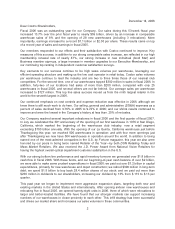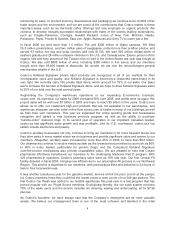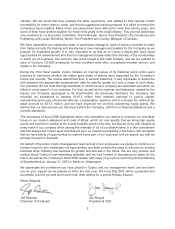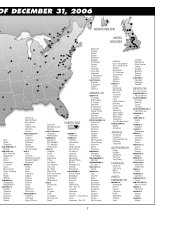Costco 2006 Annual Report Download - page 14
Download and view the complete annual report
Please find page 14 of the 2006 Costco annual report below. You can navigate through the pages in the report by either clicking on the pages listed below, or by using the keyword search tool below to find specific information within the annual report.Certain states, counties and municipalities have enacted or proposed laws and regulations that would
prevent or restrict the operations or expansion plans of certain large retailers and warehouse clubs,
including us, within their jurisdictions. We believe that, if enacted, such laws and regulations could
have a material adverse effect on our operations.
Energy Management and Conservation
The subject of energy usage continues to receive much attention. Because of our commitment to our
members to keep our prices low and because energy is a significant operating cost for us, we have
always been focused on reducing our energy consumption. As technology improves and energy costs
increase, we continue to search for new ways to improve our performance in this area. This improved
performance not only benefits our members and shareholders but the communities in which we
operate and the environment as a whole.
Our warehouses have always utilized significant numbers of skylights, which reduce electrical demand.
We turn lights on and off depending upon the time of day. This is simply one part of the energy
management system that operates in every warehouse, allowing us to better measure and control our
energy usage. We also constantly review new lighting technologies for fixtures that give us greater
illumination at lower cost. The exteriors of our warehouses use minimal lighting as compared to other
retailers.
We design and construct all of our warehouses in the United States to, in large part, meet or exceed
the demanding energy efficiency standards of California law (or higher if local law requires). This
allows us not only to operate at lower cost but to receive energy-efficiency incentive payments from
local utilities. Also, where permissible under local restrictions, we utilize metal exteriors for our
warehouses, which have superior insulation value and allow us to heat and cool the buildings with less
energy. Among other things, we use high efficiency air conditioning equipment (which we typically
operate at temperatures higher than many retailers). In addition, we have found that more rigorous
maintenance of our air conditioning systems pays off in more efficient performance. Other recent
improvements have included: switching from mechanical to electronic valves in new warehouse
refrigeration systems; changing to a refrigerant that reduces horsepower requirements for our
refrigeration systems; installing reclamation systems that use hot gas emitted from refrigeration
systems to heat water; and providing energy management systems on new pizza ovens to reduce gas
usage.
This year, we took our energy saving efforts to a new level with the installation of our first large-scale
solar (photovoltaic) panel system in one of our California warehouses. In addition to generating as
much as 500 kilowatts at peak output, the location of this system on the roof helps cool the building
through reflection of the warming rays of the sun. Our initial assessments of this system are positive,
and we are in the process of a second installation at another California warehouse. If performance
continues as we expect, this program could yield substantial benefits when rolled out to a number of
our other locations.
We also continue to focus on methods for reducing fuel consumption by trucks that keep our
warehouses in stock. These include training drivers in fuel-efficient techniques and enhanced vehicle
maintenance. In addition, this Spring we will be testing “hybrid” trucks in our business delivery
operations.
The performance of our management is measured by, among other things, what we term “controllable
expenses,” which include energy expense. This is also one of the factors in management’s
compensation. Accordingly, people throughout our Company have the incentive to continue to focus on
reducing energy usage and the attendant expense.
12
























